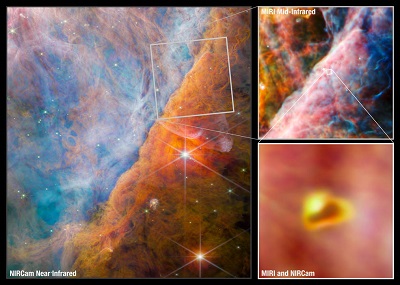Washington, (Asian independent) A team of international scientists has used the powerful James Webb Space Telescope to detect a new carbon compound in space for the first time.
While carbon compounds form the foundations of all known life, the new molecule is important because it aids the formation of more complex carbon-based molecules.
Known as methyl cation (pronounced cat-eye-on) (CH3+), the molecule was detected in a young star system, with a protoplanetary disk, known as d203-506, which is located about 1,350 light-years away in the Orion Nebula.
“This detection not only validates the incredible sensitivity of Webb but also confirms the postulated central importance of CH3+ in interstellar chemistry,” said Marie-Aline Martin-Drumel of the University of Paris-Saclay in France, a member of the science team, in a statement.
The findings, published in the journal Nature, showed that although the star in d203-506 is a small red dwarf, the system is bombarded by strong ultraviolet (UV) light from nearby hot, young, massive stars.
Scientists believe that most planet-forming disks go through a period of such intense UV radiation, since stars tend to form in groups that often include massive, UV-producing stars.
Typically, UV radiation is expected to destroy complex organic molecules, in which case the discovery of CH3+ might seem to be a surprise.
However, the team predicts that UV radiation might actually provide the necessary source of energy for CH3+ to form in the first place. Once formed, it then promotes additional chemical reactions to build more complex carbon molecules.
Further, the team noted that the molecules they see in d203-506 are quite different from typical protoplanetary disks. In particular, they could not detect any signs of water.
“This clearly shows that ultraviolet radiation can completely change the chemistry of a protoplanetary disk. It might actually play a critical role in the early chemical stages of the origins of life,” said lead author Olivier Berne of the French National Centre for Scientific Research in Toulouse, France.
The world’s premier space science observatory, Webb Telescope is an international programme led by NASA with its partners, ESA (European Space Agency) and the Canadian Space Agency.








